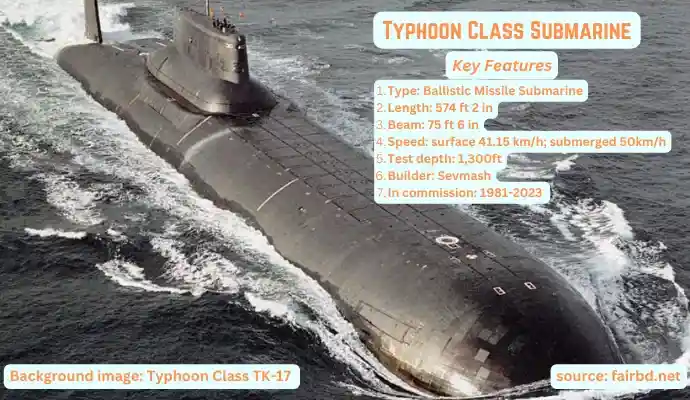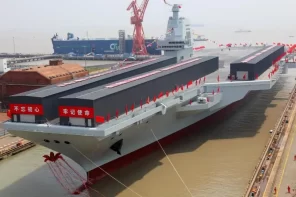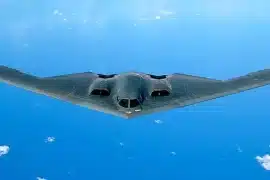The Project 941 Akula boats, known in the West as the Typhoon class, represent a remarkable chapter in the history of submarine technology. These massive vessels hold the distinction of being the largest undersea vessels. This article explores the history, capabilities, and eventual retirement of these colossal submarines.
Arctic Pioneers
The Typhoon-class submarines were specifically designed to operate within the challenging environment of the Arctic ice pack.

Featuring a unique double-hull design comprising two separate pressure hulls joined by a single outer covering, they offered enhanced protection against anti-submarine weapons. This reinforced construction also allowed them to navigate through thin ice with ease, making them difficult to track and engage under the ice shelf.
Birth of the Typhoon Class
The first Typhoon-class submarine was laid down in 1976 at Severodvinsk and commissioned in 1980, achieving full operational status in 1981. These submarines were intended to serve the Soviet Northern Fleet, particularly within the Arctic Circle.
The R-39 Rif Missile
To arm this class of submarines, the development of a fifth-generation submarine-launched ballistic missile began in 1973. Known as the R-39 Rif (Western reporting name SS-N-20 Sturgeon), this missile allowed the Typhoons to launch attacks from within the Arctic Circle and strike targets anywhere in the continental United States. Each submarine was equipped with 20 of these intercontinental ballistic missiles, capable of carrying up to 10 warheads.
Ambitious Upgrades
Originally, the Akula class submarines were intended to be retrofitted with the improved R-39M Grom (Western reporting name SS-N-28) ballistic missiles. However, the development of these upgraded missiles faced a series of testing failures, ultimately leading to the project’s abandonment.
Nuclear Powerhouse of Project 941 Akula submarines
The Typhoon-class submarines were powered by a pair of OK-650VV nuclear reactors, each with a rating of 190 MW. These reactors, designed in the 1970s, represented a more modern and safer alternative to previous Soviet submarine reactors. The same type of nuclear reactor, in slightly modified forms, was used in several other Soviet submarines, demonstrating the design’s success.
Retirement and Decommissioning
Between 1996 and 1998, three Akula-class boats were decommissioned, and these submarines were subsequently scrapped between 2005 and 2009. By 2002, only two such submarines remained in active service, primarily for testing purposes related to the R-39M Grom and new Bulava submarine-launched ballistic missiles. This decision went against the Co-operative Threat Reduction Program.
Struggles in the 21st Century
The remaining Typhoon-class submarines, Severstal and Arkhangelsk, went to reserve in 2004 and 2006, respectively. Two main factors contributed to their inactivity: the lack of ballistic missiles for these submarines and funding constraints. Production of R-39 missiles had ceased, and existing missiles were gradually destroyed due to nuclear weapons reduction treaties. In 2013, it was announced that both boats would be decommissioned and scrapped between 2018 and 2020, a process that indeed took place.
The End of an Era
By 2018, only one Project 941 Akula-class boat, the Dmitry Donskoy, remained operational, but its future was uncertain. The Dmitry Donskoy had already exceeded its planned service life of 25 years, and discussions regarding its retirement had been ongoing for years. In 2022, it was officially announced that the boat was out of service and slated for scrapping, with its reactor core depleted by 2023.
Legacy and Successors
With the retirement of Dmitry Donskoy, the era of the Akula-class submarines came to an end. Russia has transitioned to the new Borei class and Improved Borei class submarines, marking a new chapter in its naval capabilities.
In the annals of submarine history, the world will remember the Typhoon-class submarines forever as titans of the deep, pushing the boundaries of technology and serving as a testament to the engineering prowess of their time. While their era may have concluded, their legacy endures in the ongoing evolution of underwater warfare.
The next-generation Russian submarines include Graney-class submarines, which are among the most powerful attack submarines in the world.
FAQ: Typhoon-Class Submarine
What is a Typhoon-class submarine?
A Typhoon-class submarine, officially known as Project 941 Akula in Russia, is a class of nuclear-powered ballistic missile submarines (SSBNs). The Soviet Union developed these submarines during the Cold War era. They are famous for their massive size, double-hull design, and ability to carry a significant number of intercontinental ballistic missiles.
Are there any active Typhoon-class submarines?
No, as of my last knowledge update in September 2023, there are no active Typhoon-class submarines. The last remaining Typhoon-class submarine, the Dmitry Donskoy, retired from service, reported the Russian news agency TAAS on February 6, 2023.
What is the world’s largest submarine?
The Typhoon-class submarines hold the distinction of being the world’s largest submarines. No other submarine class surpasses their size and displacement.
Does Russia still use the Typhoon-class submarine?
No, Russia no longer uses Akula-class submarines in active service. Newer submarine classes, such as the Borei class and Improved Borei class submarines have replaced them.
What does the interior of an Akula-class submarine look like?
The interior of Typhoon-class submarines would typically contain living quarters for the crew, control rooms, missile silos, and various systems necessary for submarine operations. The submarine boasts ample living facilities, providing a comfortable environment for a crew of 170 during months-long submerged missions.
Did Akula-class submarines have a swimming pool?
Yes, some Typhoon-class submarines had a small swimming pool for crew recreation during long deployments. This was a unique feature that added to the submarines’ reputation for luxury and comfort.
How does the size of an Akula-class submarine compare to other submarines?
Typhoon-class submarines are the largest submarines in the world. They are larger than the U.S. Navy’s Ohio-class submarines and are in a class of their own in terms of size and displacement.
What was the cost of building a Typhoon-class submarine?
The Typhoon-class submarines were among the most expensive and technologically advanced submarines ever constructed during their time. According to the Russian news agency Tass, the cost of a Typhoon-class submarine exceeded 525 million rubles at 1980 values.
What are the dimensions of an Akula-class submarine?
A Typhoon-class submarine is approximately 175 meters (574 feet) in length, making it one of the longest submarines ever built. They have a beam (width) of about 23 meters (75 feet) and a draft of around 12 meters (39 feet).
What is the maximum operating depth of a Typhoon-class submarine?
The maximum operating depth of a Typhoon-class submarine is estimated to be around 400 meters (1,300 feet) or more. These submarines can operate at extreme depths, allowing them to navigate under the polar ice cap and remain hidden from potential threats.
Sources
- “Russia’s nuclear-powered sub Dmitry Donskoy withdrawn from service,” Tass, 6 Feb. 2023, https://tass.com/defense/1571657. Accessed October 5, 2023.
- “Russia not to modernize world’s largest Akula-class submarines,” Tass, 7 Mar. 2012, https://tass.com/archive/671290. Accessed October 5, 2023







